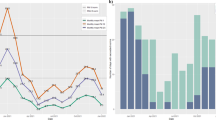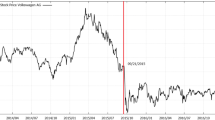Abstract
We examine the effects of an airport expansion on the prices of houses and apartments located under the planned flight paths. We focus on the role of expectations of aircraft noise during the expansion of Berlin-Brandenburg International Airport. The publication of the flight paths can be seen as an exogenous event. It provides local residents and potential home buyers with reliable information in a situation that is characterized by uncertainty. The flight paths greatly influence the expectation of the noise level. We find that property listing prices were reduced substantially in the affected areas after the flight paths were published. The loss of value of the affected properties was found to be 9.6 % on average within a slant distance of 3 km from a planned flight path. If the flight altitude is below 1,000 m, the discount is between 11.8 and 12.8 %, whereas for higher flight altitudes, the average decline in prices is estimated to be 8.3 %.

Similar content being viewed by others
Notes
See http://www.mil.brandenburg.de/sixcms/detail.php/bb1.c.155609.de for details. Schönefeld is located just outside the south-eastern city limits of Berlin.
The DFS is a company organized under private law, but owned completely by the federal state, see http://www.dfs.de/dfs_homepage/en/.
The divergence triggered an inquiry and a declaration in the parliament of Brandenburg, see http://www.mil.brandenburg.de/sixcms/media.php/4055/3498 and http://www.mil.brandenburg.de/sixcms/detail.php/468420. In question 12 of the inquiry, the Green Party (die Grünen) asked whether the projected flight paths were going to be followed closely or whether divergence from the paths was likely to occur more frequently. From the perspective of the local residents, there seemed to be a high degree of uncertainty about how to deal with the existing information such as the flight paths and noise projections throughout the planning process.
The NDI is a measure for the relative loss of value per dB, see Nelson (2008).
We would like to thank an anonymous referee for pointing this out.
The modeling of expectations has its own problems that are discussed below.
Unfortunately, there are no data available from the years prior to 2011. Therefore, it is not possible for us to examine prices before the decision in favor of Schönefeld was made.
For details on the data, the reader is referred to Kholodilin and Mense (2011).
We use takeoffs rather than landings because landing paths are much less variable due to safety regulations. Since the location of the airport has been public information at least since 2004, it is likely that prices had adjusted to the landing paths prior to 2010.
For an observation of December 2012, it is known whether it remained online in January 2013 or not.
As a robustness check, a model was estimated in which all treatment variables were interacted with the \(TOM\) dummy described above. The estimates suggest that the bias is small.
In a sense, this would be in line with the findings of Kiel and McClain (1995) who find a significant reaction of home owners to “hard” information during the siting of an incinerator, but a much smaller and instable reaction to “rumors”. Although the plans preferred by the DFS in September 2010 still had to be approved of, they were not merely “rumors”. It must have been clear to the affected persons that forcing the DFS to change their plans would require heavy protesting and lobbying.
We would like to thank an anonymous referee for pointing this out.
SXF is IATA code for Schönefeld Airport.
Modeling distance variables in this way reduces multicollinearity, while the variation in prices introduced by these local amenities is captured in the area where it is most important, following Tobler’s “first law of geography”. The choice of the cut-off point is arbitrary, but the results are robust to this choice.
We also tested models that used distance bounds instead of the nearest neighbors approach, and they produced similar results. These can be obtained from the authors upon request.
The SLM was also estimated by the spatial two-stage least squares procedure, and the SEM was estimated by GMM, with very similar results. See Kelejian and Prucha (1998), Kelejian and Prucha (2010), Arraiz et al. (2010), Piras (2010) for details about the estimators. We do not report these estimates, but they can be obtained from the authors upon request.
For dummy variables, the percentage price discounts were calculated as \(100 \times (\exp {\{b\}} - 1)\).
The decomposition of impacts for the spatial models were calculated using the approach proposed by (LeSage and Pace (2009), p. 38, eq. 2.46).
The marginal effects estimates of the SLM are much higher than the marginal effects estimates from the OLS or SEM models. The feedback mechanism is responsible for this difference. However, this mechanism might be driven by observations from the control group. Therefore, the SLM introduces an identification problem that is absent if the reasoning behind the SEM is accepted.
For group B, there are not enough observations with flight altitudes above 1,000 m in the sample, so we did not split this group.
The variance inflation factors for group B, the noise variables, and the group A dummies are all larger than 9 in this model (not reported).
References
Ahlfeldt GM, Maennig W (2007) Assessing external effects of city airports: land values in Berlin. In: Working Papers 011, University of Hamburg
Ahlfeldt GM, Maennig W (2011) External productivity and utility effects of city airports. Technical report, London School of Economics and Political Science
Anderson ST, West SE (2006) Open space, residential property values, and spatial context. Reg Sci Urban Econ 36(6):773–789
Arraiz I, Drukker DM, Kelejian HH, Prucha IR (2010) A spatial cliff-ord-type model with heteroskedastic innovations: small and large sample results. J Reg Sci 50(2):592–614
Bauer TK, Braun S, Kvasnicka M (2013) Distant event, local effects? Fukushima and the German Housing Market. Ruhr, Economic Papers 433 1857, RWI
Boes S, Nüesch S (2011) Quasi-experimental evidence on the effect of aircraft noise on apartment rents. J Urban Econ 69(2):196–204
Bowen WM, Mikelbank BA, Prestegaard DM (2001) Theoretical and empirical considerations regarding space in hedonic housing price model applications. Growth Chang 32(4):466–490
Cheshire P, Sheppard S (2004) Capitalising the value of free schools: the impact of supply characteristics and uncertainty. Econ J 114(499):397–424
Cohen JP, Coughlin CC (2008) Spatial hedonic models of airport noise, proximity, and housing prices. J Reg Sci 48(5):859–878
Dinkel M, Kurzrock B-M (2012) Angebots- und Transaktionspreise von selbstgenutztem Wohneigentum im Ländlichen Raum. J Interdiscip Prop Res 13(1):5–23
ECAC (1997) Report on standard method of computing noise contours around civil airports. Technical report, European Civil Aviation Conference
Espey M, Lopez H (2000) The impact of airport noise and proximity on residential property values. Growth Change 31(3):408–419
Faller B, Helbach C, Vater A, Braun R (2009) Möglichkeiten zur Bildung eines Regionalindex Wohnkosten unter Verwendung von Angebotsdaten. Research note 34, RatSWD
Ibbeken S (2011) Strategische Lärmkartierung gemäss Richtlinie 2002/49/EG im Land Brandenburg. Verkehrsflughafen Berlin-Schönefeld (2010) Technical report, Wölfel Meßsysteme Software
Ibbeken S (2012) Strategische Lärmkartierung gemäss Richtlinie 2002, 49, EG im Land Brandenburg. Verkehrsflughafen Berlin-Schönefeld (vorhersehbare Lärmsituation, (2015) – Flughafen BER). Technical report, Wölfel Meßsysteme Software
Jud G, Winkler D (2006) The announcement effect of an airport expansion on housing prices. J Real Estate Financ Econ 33(2):91–103
Kelejian HH, Prucha IR (1998) A generalized spatial two-stage least squares procedure for estimating a spatial autoregressive model with autoregressive disturbances. J Real Estate Financ Econ 17(1):99–121
Kelejian HH, Prucha IR (2010) Specification and estimation of spatial autoregressive models with autoregressive and heteroskedastic disturbances. J Econom 157(1):53–67
Kholodilin KA, Mense A (2011) Can internet ads serve as an indicator of homeownership rates? In: Working Paper 1168, DIW Berlin
Kiel KA, McClain KT (1995) House prices during siting decision stages: the case of an incinerator from rumor through operation. J Environ Econ Manag 28(2):241–255
Knight JR (2002) Listing price, time on market, and ultimate selling price: causes and effects of listing price changes. Real Estate Econ 30(2):213–237
LeSage JP, Pace RK (2009) Introduction to spatial econometrics. CRC Press, Boca Raton
Levesque TJ (1994) Modelling the effects of airport noise on residential housing markets: a case study of Winnipeg International Airport. J Transp Econ Policy 28(2):199–210
McMillen DP (2004) Airport expansions and property values: the case of Chicago O’Hare Airport. J Urban Econ 55(3):627–640
Merlo A, Ortalo-Magné F (2004) Bargaining over residential real estate: evidence from England. J Urban Econ 56(2):192–216
Nelson JP (2004) Meta-analysis of airport noise and hedonic property values. J Transp Econ Policy 38(1): 1–28
Nelson JP (2008) Hedonic property value studies of transportation noise: aircraft and road traffic. In: Baranzini A, Ramirez J, Schaerer C, Thalmann P (eds) Hedonic methods in housing markets. Pricing environmental amenities and segregation. Springer, Berlin, pp 57–82
Piras G (2010) sphet: Spatial models with heteroskedastic innovations in R. J Stat Softw 34(1):1–21
Pope JC (2008) Buyer information and the hedonic: the impact of a seller disclosure on the implicit price for airport noise. J Urban Econ 63(2):498–516
Püschel R, Evangelinos C (2012) Evaluating noise annoyance cost recovery at Düsseldorf International Airport. Transp Res Part D 17:598–604
Rosen S (1974) Hedonic prices and implicit markets: product differentiation in pure competition. J Polit Econ 82(1):34–55
Salvi M (2007) Spatial estimation of the impact of airport noise on residential housing prices. In: Working paper series, SSRN eLibrary
Tomkins J, Topham N, Twomey J, Ward R (1998) Noise versus access: the impact of an airport in an Urban property market. Urban Stud 35(2):243–258
Wilhelmsson M (2000) The impact of traffic noise on the values of single-family houses. J Environ Plan Manag 43(6):799–815
Yavas A, Yang S (1995) The strategic role of listing price in marketing real estate: theory and evidence. Real Estate Econ 23(3):347–368
Acknowledgments
Our thanks go to trainee Dmitry Chervyakov for his excellent research assistance. We also like to thank the two anonymous referees for their very helpful comments. Furthermore, the paper benefited from the remarks of Jürgen Kähler and Anne Spiroch.
Author information
Authors and Affiliations
Corresponding author
Rights and permissions
About this article
Cite this article
Mense, A., Kholodilin, K.A. Noise expectations and house prices: the reaction of property prices to an airport expansion. Ann Reg Sci 52, 763–797 (2014). https://doi.org/10.1007/s00168-014-0609-1
Received:
Accepted:
Published:
Issue Date:
DOI: https://doi.org/10.1007/s00168-014-0609-1




